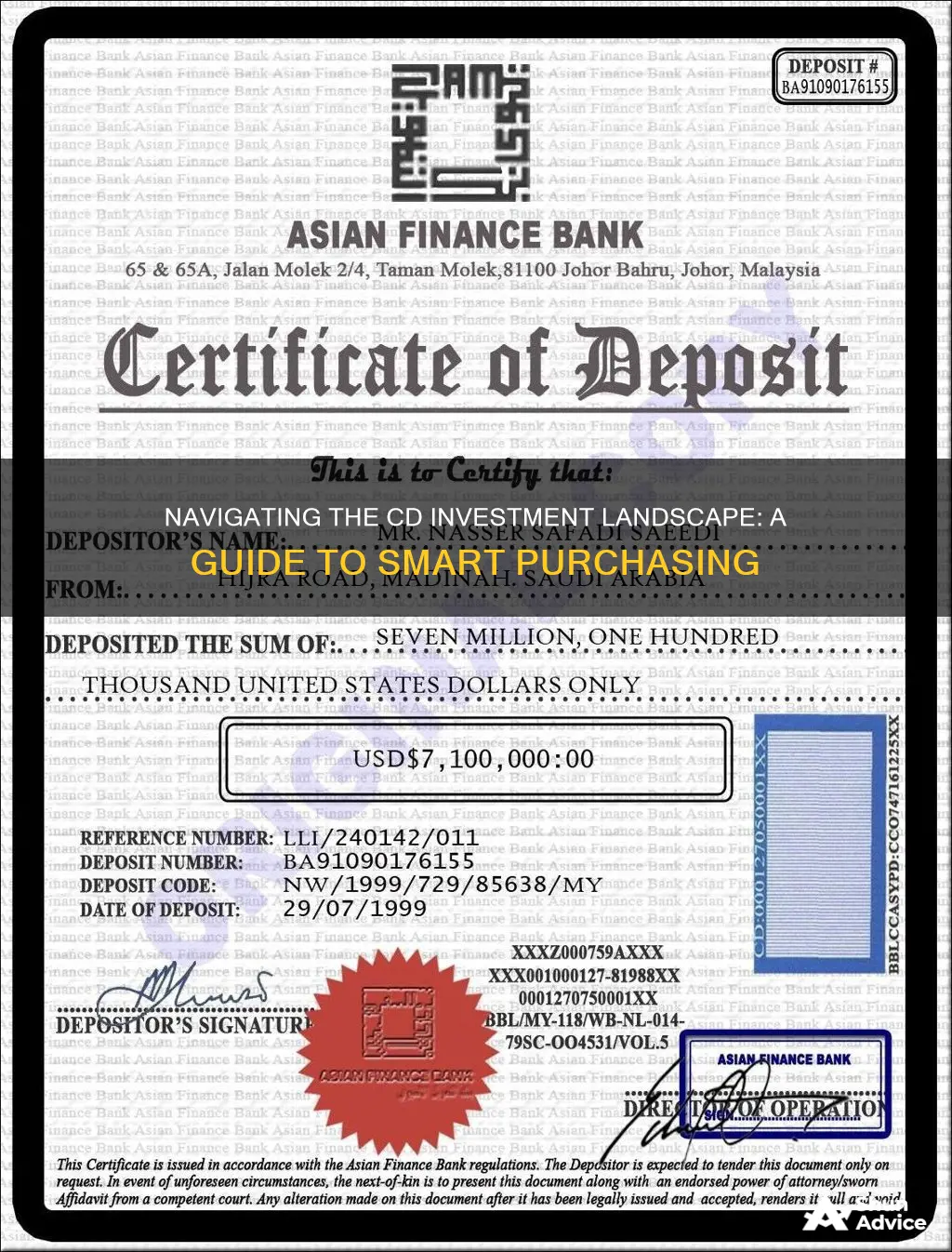
Certificates of Deposit (CDs) are a stable, short-term cash investment option, similar to a traditional savings account or money market fund. CDs are federally insured savings accounts where you invest funds for a specified period and earn interest. They are considered low-risk assets and are ideal for those seeking a safe place to earn a predictable income. CDs are purchased through financial institutions like banks and credit unions. When you buy a CD, you essentially loan money to the financial institution, which then pays you back in fixed, regular payments.
| Characteristics | Values |
|---|---|
| Type of Investment | Fixed income |
| Investment Options | Brokered CDs, Bank CDs |
| Interest Rate | Set rate over a fixed time period |
| Investment Period | Short-term, Mid-term, Long-term |
| Investment Amount | Minimum US$1,000, No minimum investment requirement |
| Returns | Higher than savings accounts, Fixed, predictable |
| Risk | Low, Federally insured |
| Accessibility | Illiquid, Early withdrawal penalty |
| Taxation | Interest taxed as ordinary income |
What You'll Learn

CD Ladders
A CD ladder is a savings strategy that combines the benefits of short- and long-term CDs, allowing you to access higher interest rates while also having access to your money at regular intervals.
To create a CD ladder, you divide a lump sum of cash across multiple certificates of deposit (CDs) with different maturity dates. This strategy provides the advantage of higher interest rates typically associated with long-term CDs, while also offering the flexibility of frequent access to your money through the shorter-term CDs.
Here's an example of how to build a CD ladder:
Let's say you have $10,000 that you want to invest in a CD ladder. You would divide this sum into five CDs with different term lengths:
- $2,000 in a one-year CD
- $2,000 in a two-year CD
- $2,000 in a three-year CD
- $2,000 in a four-year CD
- $2,000 in a five-year CD
As each CD matures, you reinvest the money into a new five-year CD. After five years, your ladder will have five five-year CDs, with one maturing each year. This provides you with access to a portion of your money each year, along with the benefit of the higher interest rates associated with long-term CDs.
However, there are also some downsides to consider. CD ladders require you to track multiple maturity dates, and there is no guarantee that the rate of return will keep up with inflation. Additionally, you may need to withdraw your money before maturity due to changing savings goals or low rates, which can result in early withdrawal penalties.
Alternative CD ladder structures include creating a ladder with only short-term CDs for those who are hesitant about long-term commitments or focusing on longer-term CDs if you want more stability. You can also vary the amounts invested in each CD based on economic projections and interest rate trends.
UK Investors: Who and How Many?
You may want to see also

CD Barbells
A CD barbell strategy is an investing technique that uses two extremes: long-term CDs with high yields and short-term CDs with low yields. The goal of this strategy is to maximise your yields while preserving flexibility. The name comes from the way the funds are clustered at either end of the maturity structure, much like a barbell has weights clustered at either end of the bar.
A CD barbell strategy can help you earn a higher interest rate while providing flexibility when you need to access your funds. It is a good option if you have clear short- and long-term goals and are comfortable managing your CDs on a rolling basis as they mature.
Here's how it works: you split your money between short-term and long-term CDs, with no money invested in medium-term options. The benefit is that you get greater access to your money with the short-term CDs, while taking advantage of the potentially higher rates with the long-term CDs.
For example, a common barbell CD strategy might be to divide your savings between short-term CDs with maturities of less than one year and long-term CDs with maturities of five years or more. The short-term CDs mature quickly (for example, in six or nine months), freeing up cash, while the long-term CDs provide greater yields.
Let's say you have $10,000 to invest. Using a barbell strategy, you would put $5,000 into a short-term CD and $5,000 into a long-term CD with the following terms and rates:
- Short-term: 6-month CD with 1.5% APY
- Long-term: 5-year CD with 2.5% APY
At the end of the five years, you will have earned an overall average yield of 2.0% (1.5%+2.5%/2).
The barbell strategy gives you greater flexibility to use your money how you want, while taking advantage of higher interest rates.
Investing: A Personal Choice
You may want to see also

CD Bullets
A CD bullet strategy is a way of investing in certificates of deposit (CDs) that focuses on a future purchase. It involves buying CDs of different terms that all mature at the same time. Here's how it works:
Let's say you're planning to buy a house in five years. You put your money in a five-year CD. Three years later, you can afford to invest more money, so you open a new CD with a three-year term. A year before your initial CD matures, you invest in another CD, this time choosing a one-year term. At the end of the five years, all your CDs mature at the same time.
This strategy is useful if you're saving for a big expense, such as a wedding or a down payment on a house. CDs tend to have higher interest rates than other bank accounts, but they don't usually allow you to add money gradually. A CD bullet strategy gets around this by letting you invest in shorter-term CDs over time, so you can earn more interest on the funds you've saved since opening your initial CD.
Presidential Election Outcomes: Navigating the Investing Landscape
You may want to see also

Brokered CDs
Brokered certificates of deposit (CDs) are issued by banks for the customers of brokerage firms. The CDs are usually issued in large denominations, and the brokerage firm divides them into smaller denominations for resale to its customers. Brokered CDs are similar to bank CDs in many ways: both pay a set interest rate that is generally higher than a regular savings account, and both are debt obligations of an issuing bank. They also both repay your principal with interest if they are held to maturity and are FDIC-insured up to $250,000 per account owner, per issuer.
However, there are some key differences. Brokered CDs can be purchased from different issuing banks, allowing you to expand your FDIC protection beyond the $250,000 limit in a single account registration type. They also come with a variety of coupon payment frequencies and can be Callable or Call Protected. Brokered CDs also come with a secondary market, meaning they don't have to be held to maturity. They also tend to have lower yields than other higher-risk investments.
To buy a brokered CD, you'll need a brokerage account. A broker will set a minimum investment amount, typically $1,000, and minimum increments for adding funds. If you're buying a new-issue CD, there are usually no upfront costs. If you're buying on the secondary market, your broker might charge you a fee.
Terms: A typical bank CD's term length is between three months and five years. A brokered CD can offer much more flexibility, with terms ranging between one month and 20 years.
Interest distribution: A bank CD allows you to take advantage of compound interest and pays all of it at the maturity date. Brokered CDs, on the other hand, don't compound interest. Some send interest payments in regular periods, and others at maturity. If you want to earn on your yield, you'll have to reinvest the interest yourself.
Early withdrawal: If you withdraw money early from a bank CD, you'll usually pay a penalty worth months of interest. With a brokered CD, you sell the CD instead and might only need to pay a small fee.
Pros and cons of a brokered CD:
- Greater liquidity. The option to sell the CD at the secondary market allows you to pull the funds out early without having to worry about high penalties.
- Longer terms. You can purchase a brokered CD with a term length of up to 20 years, or even 30 years in some cases, and keep earning a fixed interest rate.
- Keep multiple CDs in the same brokerage account. This can help you protect larger amounts of money, provided the issuing banks are insured by the FDIC.
- Earn higher returns. In general, brokered CDs earn higher APYs than bank CDs.
However, brokered CDs come with certain risks. For example, when interest rates are rising, you might lose money on a brokered CD if you sell it before the maturity date. The issuing bank can also call a brokered CD, which may cause you to miss out on potential future earnings. Interest on brokered CDs is also not compounded.
Investing: How to Choose Wisely
You may want to see also

CD Interest Rates
CDs, or Certificates of Deposit, are a type of savings account where you fix your funds for a set period, in exchange for a guaranteed interest rate. CD interest rates are typically higher than those of a regular savings account.
The interest rate is set at the opening of the term and will not change until the CD matures. The interest compounds daily, and can be paid out monthly, quarterly, semi-annually, annually, or at maturity.
CD terms usually range from three months to five years, but can be as short as a few months, or longer than five years. The interest rate is usually higher the longer the term.
- Quontic Bank: 3 months - 5 years, 4.30% - 5.50% APY, $500 minimum deposit
- Popular Direct: 3 months - 5 years, 4.25% - 5.35% APY, $10,000 minimum deposit
- Vio Bank: 6 months - 5 years, 2.75% - 5.25% APY, $500 minimum deposit
- America First Credit Union: 3 months - 5 years, 4.20% - 5.25% APY, $500 minimum deposit
- Sallie Mae Bank: 6 months - 5 years, 4.00% - 5.20% APY, $2,500 minimum deposit
- Synchrony Bank: 3 months - 5 years, 0.25% - 5.15% APY, no minimum deposit
- Marcus by Goldman Sachs: 6 months - 5 years, 4.00% - 5.15% APY, $500 minimum deposit
- Barclays Bank: 6 months - 5 years, 3.50% - 5.10% APY, no minimum deposit
- Capital One: 6 months - 5 years, 3.90% - 5.00% APY, no minimum deposit
- Citizens Access: 1 year - 5 years, 3.35% - 5.00% APY, $5,000 minimum deposit
Unlocking Private Equity: Investors' Perspective
You may want to see also
Frequently asked questions
CD stands for Certificate of Deposit. It is a fixed-income investment that offers a set interest rate over a fixed time period.
You can buy a CD investment through banks, credit unions, or brokerages.
CDs are very safe investments. They are protected by FDIC insurance up to $250,000 and offer a guaranteed interest rate that is typically higher than a savings account.
You may face early withdrawal penalties if you need to access your money before the CD matures. CDs may also offer lower returns compared to other investments, such as stocks and ETFs.
There are a few strategies you can use when investing in CDs, such as the CD ladder, CD barbell, and CD bullet. These strategies involve opening multiple CDs with different term lengths to take advantage of different rates and achieve different goals.







